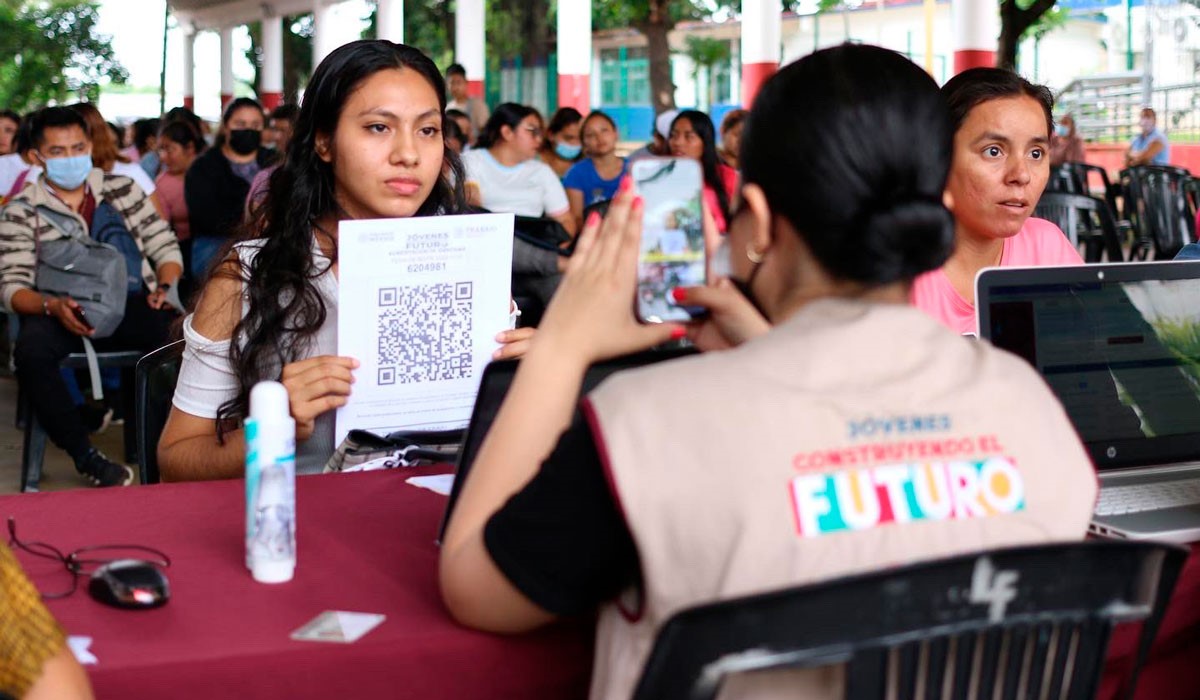By Ms. Maria de Ibarrola
Researcher at the Department of Educational Research at the Center
Research and Advanced Studies of the National Polytechnic Institute
Young People Building the Future is a federal program of national scope that has had an important presence among the welfare policies of the current administration. It has been a very pertinent program in that it is oriented towards the solution of one of the most serious national and international problems of the time: the number of young people who are not included in any of the two most important activities in their life and in their development as citizens: school and work.
It has also been a very attractive program, offering young people - who, under oath, do not study or work when making their application - the possibility of acquiring work experience, for up to twelve months, directly in a workplace of their choice - although close to their home - and personally financing their stay through a scholarship equivalent to a minimum wage; the amounts are the highest among the scholarships granted by the federal government: $ 3 600 in 2019, $7 572.00 in 2024; at the same time, the STPS endorses a medical record in Social Security for the duration of the experience. It is up to the workplace to propose a training program and assign an experienced worker as a tutor for the apprentice. Upon completion of the program, the apprentice receives a certificate of the areas in which he has been trained and the skills acquired. The certificate is signed by the president of the republic as an endorsement of the veracity of the document.
The program has been extraordinarily simple, which contributes to its feasibility. It directly assumes the position that it is the lack of work experience that hinders young people from finding “decent” work and distributes the responsibility for offering this opportunity among hundreds of thousands of work centers of all sizes and types, since there are work centers in every locality in the country; up to 450,000 were registered. It makes no distinctions between young people by sex, age, previous education or work history. It is not coordinated with any other training body: school system, training centers or institutes or official bodies for certifying work skills.
Results have been released on the Program's achievements, in particular the number of young people served, nearly three million in the five years that have passed, and the budget amount spent, 106 billion pesos in that period. The public results, however, do not go beyond very general figures. The most important are based on two INEGI studies (2021 and 2023), which concluded that young people participating in the PJCF had greater chances of working, compared to those who had not participated.
The PJCF has not been concerned with implementing indicators or methodologies that allow us to know what the work experience that each workplace provides consists of, which is surely very different, nor what young people learn, nor does it monitor graduates to find out their destination. In no case does it analyze the possible relationship between the different factors that coincide in the development of the experience.
Given the great appeal of the program, the originality and strength of its proposal, a group of researchers agreed to carry out an eminently qualitative research, focused on learning from the voice and experience of the actors: heads of work centers, apprentices, tutors, and graduates, what the results in this regard could be.
The starting point of the research was based on five academic results that allowed us to question the efficiency of the program for the objectives sought: the inequality and structural heterogeneity of the work centers and the municipalities in which they are located; the limits of situated learning; socioeconomic differences and school trajectories, the importance of school training, employment for young people without school or work, and the limits of work experience in obtaining a job.
This was a qualitative study in which 20 work centres, defined as the fundamental context of the experience, participated voluntarily. In these centres we had the opportunity to interview in depth the people in charge of the programme, tutors, apprentices and graduates. A total of 100 interviews were carried out and analysed, in addition to the continuous monitoring of information about the Programme.
The results of this research offer very important elements to take into consideration for a diagnosis of PJCF.
The most important was the structural inequality between the 20 work centers, fundamental differences between large corporations and micro centers with no more than 10 workers, sometimes only three. This diversity modifies the reasons why the centers have participated in the PJCF: in the first case, they have done so at the invitation of the federal government to contribute to an important program in favor of youth and have contributed additional financial and human resources to the operation of the program. In the second, the motivation has been to take advantage of the youth's labor force for free, in exchange for training them, a situation in which everyone wins. A third type of center participated, which we call comprehensive training centers, operated by civil society organizations that have specialized in serving marginalized youth, who they serve with a tripartite program: personal development and life plan, continuous and direct advice to obtain the corresponding school certificates through open systems, and training for work.
The type of centres determines the type of training programmes and the training and dedication of the tutors. In one case, the company's training staff, in others a worker learns to "tutor by tutoring." In the comprehensive training centres, they are university professionals with training and experience in dealing with young people from marginal areas. The type of workplace also determines the type of apprentices they recruit. In the participating cases, there was a priority orientation towards young people with higher education, except in the comprehensive training centres, which were aimed at young people with incomplete compulsory schooling. The centres were able to hire some apprentices, but in a much lower number than those they were able to train.
The second major result is that, regardless of this structural diversity, when there is commitment on the part of the centers, tutors and apprentices, which was the case in our voluntary sample, the experience is extremely positive and favorable. The apprentices, graduates and tutors report with enthusiasm and gratitude the acquisition of technical skills, in this case very limited by the field, organization, technology and size of the work center, but they also proudly express the acquisition of socio-labor and socio-emotional skills that seem to go beyond the specific work situation and are very significant for the development of the apprentices. The experience turned out to be highly valued by them,
The participation of the tutor, almost all of whom are female tutors, is a condition without which the experience does not have favorable or profound results. The tutor performs fundamental educational functions.
The scholarship is undoubtedly the most important factor in the program's feasibility. Young people have many uses for it, from the possibility of ensuring economic autonomy and covering personal expenses, to financing areas of interest in the future such as further studies or work ventures. They all contribute with their scholarship to improve the living conditions of their families.
Graduates may have different immediate futures: some are hired by the center itself, they are called “success stories”, others are recommended to similar centers, a small number started their own businesses. All, without exception, consider it important to continue studying to improve their job positions.
Based on these results, we have come up with some recommendations for the continuation of the Program.
The most important thing is to take a brief break and make the complete statistics of the program transparent in order to facilitate a greater and better understanding of its results and the concatenation of factors that lead to them.
Prioritise young people who have not completed secondary school and facilitate combined work and school activities that allow them to complete compulsory schooling while gaining work experience.
To reach agreements with schools, training centres and civil society organisations, given the importance of these other institutions, supporting workplaces to provide the best and most significant work experience and training for young people.
[1] This article is based on the research report “The Youth Building the Future Program, The Voice and Experience of the Actors. A Qualitative Research.” María de Ibarrola (DIE Cinvestav) general coordinator, Enrique Pieck (INIDE UIA), Estela Ruiz Larraguivel (IISUE UNAM), Roxana Vicente Diaz (ITESM), Elena Torres, (DIE Cinvestav), Ivonne Cárdenas (DIE Cinvestav) (in process of publication)






